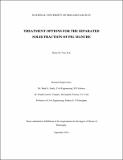| dc.description.abstract | Landspreading of pig manure in quantities greater than that required by plants can result in pollution of ground and surface water bodies. Recent regulations have placed restrictions on the application of manure to land, while further more stringent restrictions will come into force in the coming years. To comply with these regulations, it is estimated that pig farmers will require approximately 50% more spreadlands for manure application in 2017 than is the case in 2012. This will increase the cost of landspreading pig manure and, therefore, alternative viable on-farm treatment options for pig manure are urgently required. Composting and pyrolysis of the separated solid fraction of pig manure may be a solution to this problem.
A composting experiment was designed to identify the most effective readily available bulking agents to produce stable and mature compost from the separated solid fraction of pig manure. Of the bulking agents investigated, sawdust was found to be the best, due to its large surface area and small particle size. A second composting experiment was then designed to investigate the required ratio of sawdust addition to pig manure. Two ratios of separated pig manure solids-to-sawdust (w/w) were examined: 4:1 and 3:2. It was found that the lower ratio of sawdust addition produced stable compost, while the decreased sawdust requirement also reduced costs. An economic analysis, conducted to determine the viability of separation and composting of pig manure in Ireland, suggested that pig manure composting is not currently viable due to the high cost of separation, but may become viable in the future if a cheaper method of separation is used, and if oil prices continue to rise.
A pyrolysis experiment was designed to produce and characterise biochar, bio-liquid and gas from pig manure, and to examine the impact of the addition of different rates of sawdust on the energy yield. Increasing the sawdust content in the wood/manure mixture increased the resultant biochar and gas heating values, but reduced bio-liquid heating values. The nutrient concentrations of the biochar were reduced with increasing sawdust content in the wood/manure mixture. The effect of composting the feedstock before pyrolysis was also examined. An energy balance was conducted on the processes of separation, composting and pyrolysis of pig manure. A positive net energy yield was produced from these technologies with the addition of sawdust to the manure. Composting the feedstock before pyrolysis reduced the net energy yield.
The effect of amending soil with two types of biochar, produced from pig manure and wood, on nutrient leaching, soil properties and greenhouse gas emissions, was also examined. Both types of biochar affected the nitrogen (N) cycling process within the soil, which, in turn, reduced nitrate (NO3-) leaching and increased nitrous oxide (N2O) emissions. Emissions of carbon dioxide (CO2) were higher in the biochar-amended soils due to a higher rate of mineralization. The soil water, organic matter, carbon (C) and N contents were impacted when both types of biochar were added. The biochar produced from pig manure released phosphorus (P), and resulted in higher P contents both in the soil and in the leachate.
This study showed that composting and pyrolysis can be used as alternatives to landspreading of pig manure. However, at present, neither of these treatment methods is currently viable for on-farm implementation. Composting is a proven technology and can be quickly implemented at farm-scale, but using the techniques of this study, the cost of slurry separation with a decanter centrifuge would be prohibitively expensive. However, composting of pig manure following a cheaper method of separation should be investigated, and may be economically viable. Pyrolysis of separated pig manure may be an alternative to landspreading in the future. However, farm-scale studies would be first required to investigate whether the laboratory results of the present study can be replicated on a larger scale. The current method of landspreading pig manure remains the most feasible manure treatment option at the current time. This study showed that the application of biochar to soil can reduce nutrient leaching, and may be an effective method of reducing surface and ground water contamination after landspreading of pig manure. However, further studies are required to examine different soil types, biochar types and application rates. | en_US |


